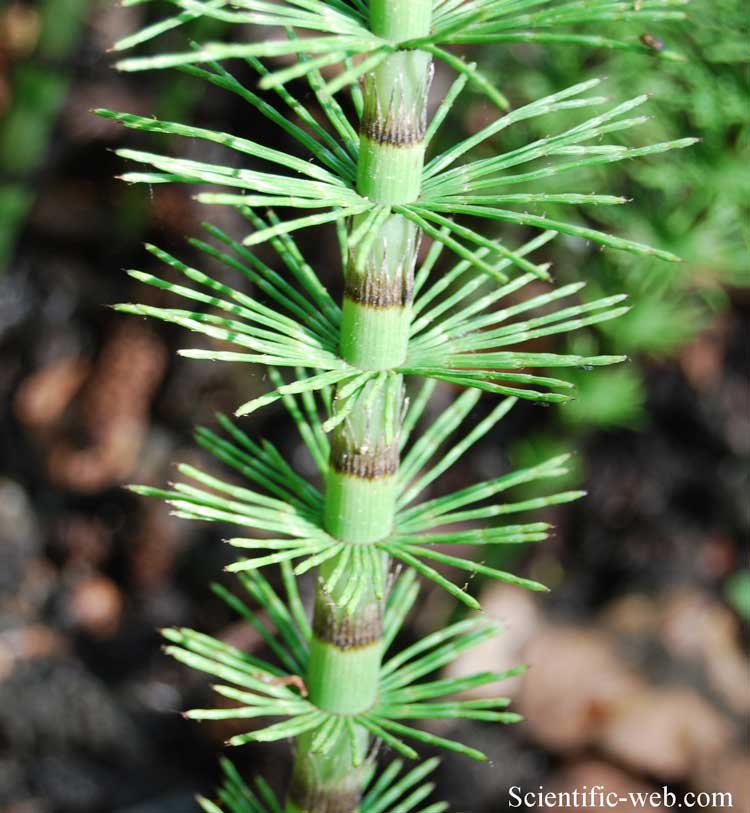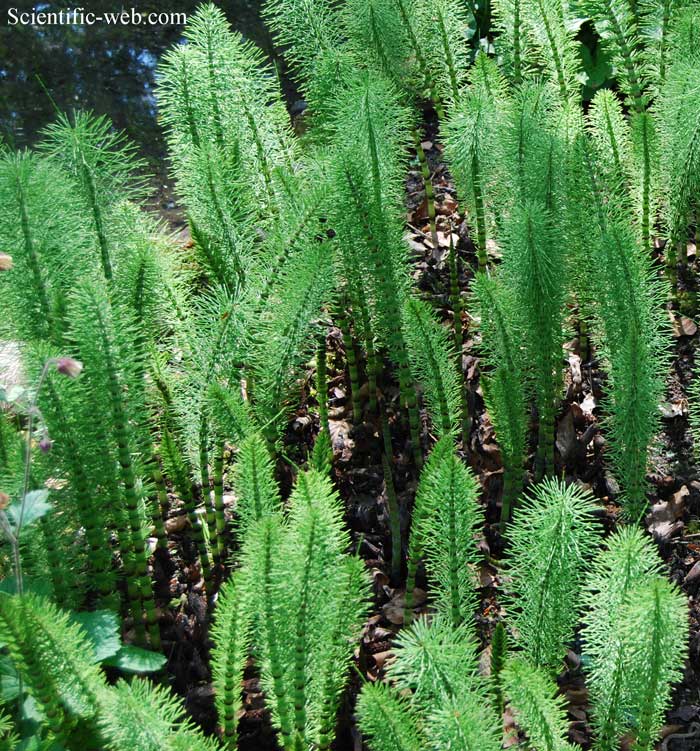
Equisetum telmateia, Photo: Michael Lahanas
Superregnum: Eukaryota
Regnum: Plantae
Divisio: Tracheophyta
Divisio: Pteridophyta
Classis: Equisetopsida
Ordo: Equisetales
Familia: Equisetaceae
Genus: Equisetum
Subgenus: E. subg. Equisetum
Species: Equisetum telmateia
Subspecies: E. t. subsp. braunii – E. t. subsp. telmateia
Name
Equisetum telmateia Ehrh.
References
Ehrhart, J.F., 1783. Hannoverisches Magazin. 18: 287.
Links
Hassler, M. 2020. Equisetum telmateia – World Ferns: Checklist of Ferns and Lycophytes of the World . In: Roskov Y., Orrell T., Nicolson D., Bailly N., Kirk P.M., Bourgoin T., DeWalt R.E., Decock W., De Wever A., Nieukerken E. van, Zarucchi J. & Penev L. (eds.) 2020. Species 2000 & ITIS Catalogue of Life. Published on the internet. Accessed: 2020 Apr 17.
Govaerts, R. et al. 2020. Equisetum telmateia in Kew Science Plants of the World Online. The Board of Trustees of the Royal Botanic Gardens, Kew. Published online. Accessed: 2020 Apr 17. Reference page.
International Plant Names Index. 2020. Equisetum telmateia. Published online. Accessed: Apr 17 2020.
Tropicos.org 2020. Equisetum telmateia. Missouri Botanical Garden. Published online. Accessed: 17 Apr 2020.
Equisetum telmateia at the Euro+Med PlantBase
USDA, ARS, Germplasm Resources Information Network. Equisetum telmateia in the Germplasm Resources Information Network (GRIN), U.S. Department of Agriculture Agricultural Research Service.
Vernacular names
беларуская: Хвошч вялікі
català: Cua de cavall grossa
čeština: Přeslička největší
dansk: Elfenbens-Padderok
Deutsch: Riesen-Schachtelhalm
English: Great Horsetail
suomi: Jättikorte
français: Grande prêle
עברית: שבטבט גדול
magyar: Óriás zsurló
italiano: Equiseto massimo
lietuvių: Didysis asiūklis
македонски: Коњско опавче
Nederlands: Reuzenpaardenstaart
norsk: Kjempesnelle
polski: Skrzyp olbrzymi
português: Grande Cavalinha
русский: Хвощ большой
српски / srpski: Велики раставић

Equisetum telmateia, Photo: Michael Lahanas
Equisetum telmateia, the great horsetail or northern giant horsetail, is a species of Equisetum (puzzlegrass) with an unusual distribution, with one subspecies native to Europe, western Asia and northwest Africa, and a second subspecies native to western North America.[1][2] The North American subspecies is often simply but ambiguously called "giant horsetail", but that name may just as well refer to the Latin American Equisetum giganteum and Equisetum myriochaetum.
Description
It is an herbaceous perennial plant, with separate green photosynthetic sterile stems, and pale yellowish non-photosynthetic spore-bearing fertile stems. The sterile stems, produced in late spring and dying down in late autumn, are 30–150 cm (rarely to 240 cm) tall (the tallest species of horsetail outside of tropical regions) and 1 cm diameter, heavily branched, with whorls of 14–40 branches, these up to 20 cm long, 1–2 mm diameter and unbranched, emerging from the axils of a ring of bracts. The fertile stems are produced in early spring before the sterile shoots, growing to 15–45 cm tall with an apical spore-bearing strobilus 4–10 cm long and 1–2 cm broad, and no side branches; the spores disperse in mid spring, with the fertile stems dying immediately after spore release. It also spreads by means of rhizomes that have been observed to penetrate 4 meters into wet clay soil, spreading laterally in multiple layers.[3] Occasionally plants produce stems that are both fertile and photosynthetic.[2][4][5]
Equisetum telmateia subsp. braunii, San Jose, California, showing green stem
Spore-bearing strobilus
Subspecies
There are two subspecies:[1][4]
Equisetum telmateia subsp. telmateia. Great horsetail. Europe, western Asia, northwest Africa. Main stem between branch whorls pale greenish white.
Equisetum telmateia subsp. braunii (Milde) Hauke. Northern giant horsetail. Western North America, from southeastern Alaska and western British Columbia south to California. Main stem between branch whorls green.
Habitat
It is found in damp shady places, spring fens and seepage lines, usually in open woodlands, commonly forming large clonal colonies.[2][5]
References
"Equisetum telmateia". Germplasm Resources Information Network (GRIN). Agricultural Research Service (ARS), United States Department of Agriculture (USDA). Retrieved 1 January 2018.
Hyde, H. A., Wade, A. E., & Harrison, S. G. (1978). Welsh Ferns. National Museum of Wales ISBN 0-7200-0210-9.
http://www2.fiu.edu/~chusb001/GiantEquisetum/Ecophysiology.html#RhizArch
Flora of North America: Equisetum telmateia
Clapham, A. R.; Tutin, T. G. & Warburg, E. F. (1981). Excursion Flora of the British Isles (3rd ed.). Cambridge: University Press. p. 6. ISBN 0-521-23290-2.
Retrieved from "http://en.wikipedia.org/"
All text is available under the terms of the GNU Free Documentation License

